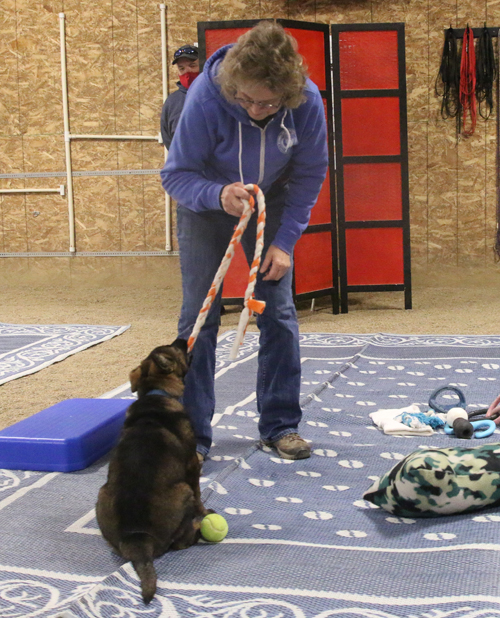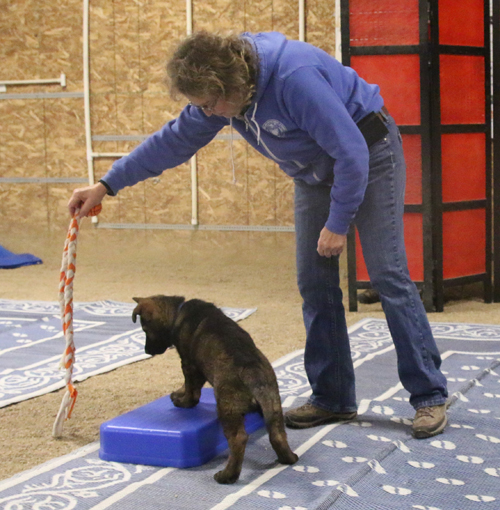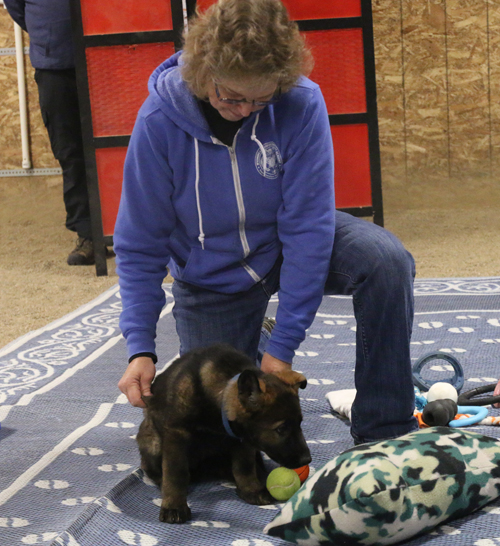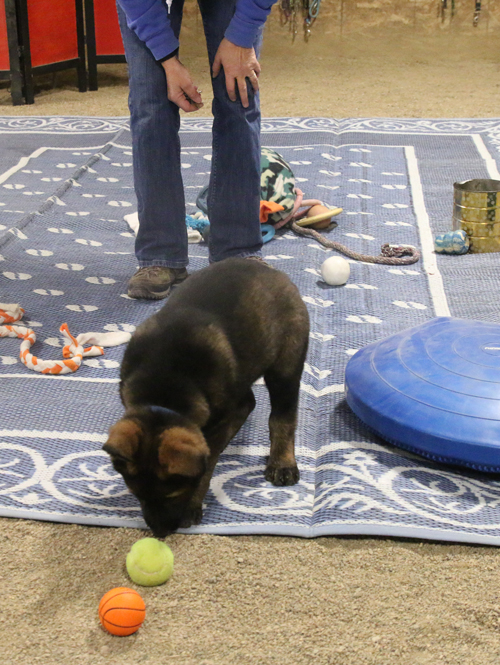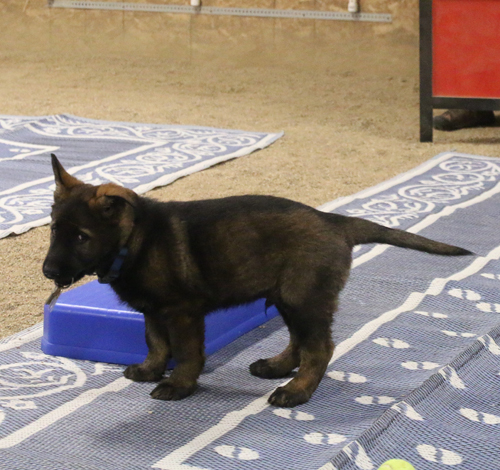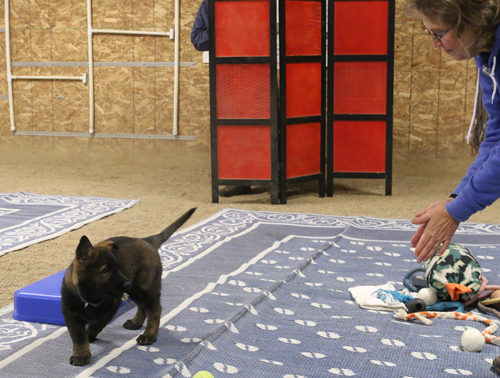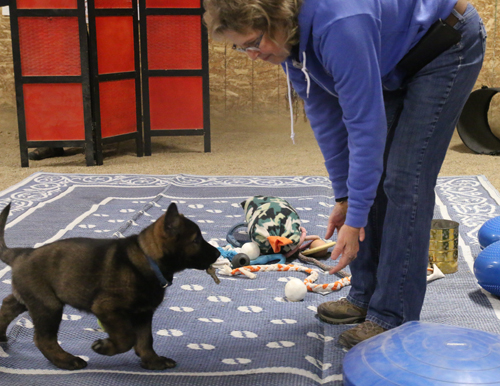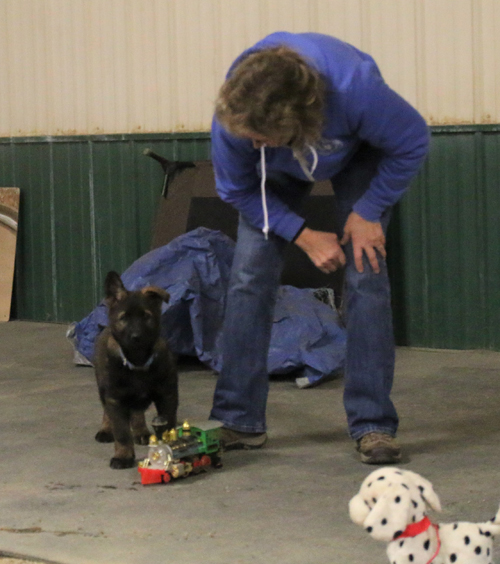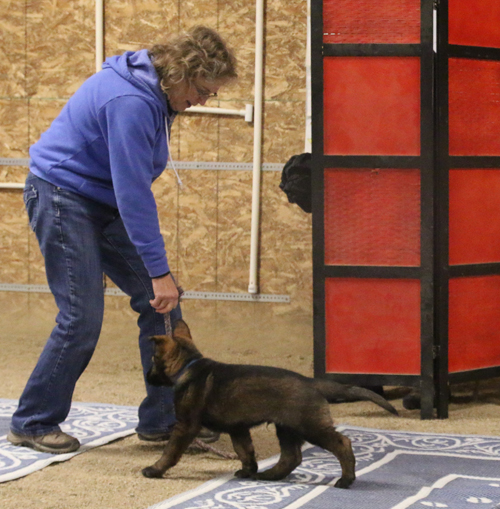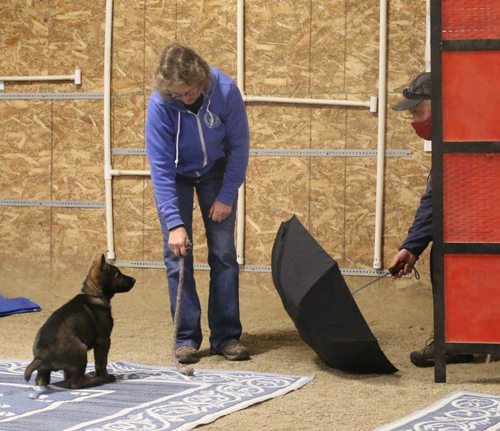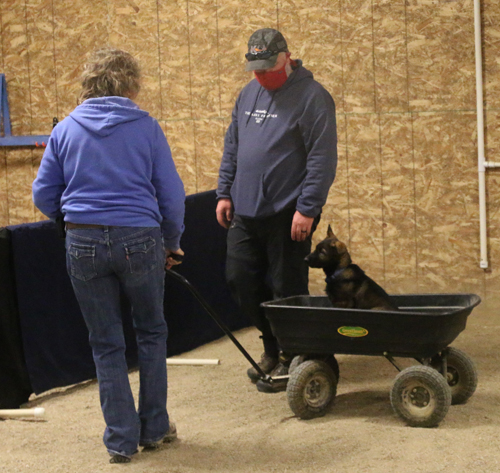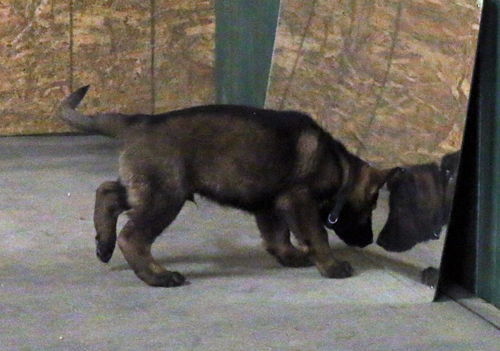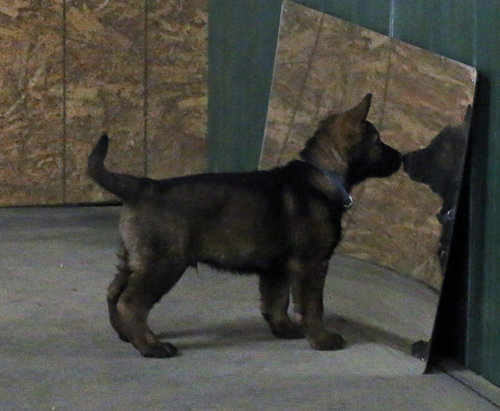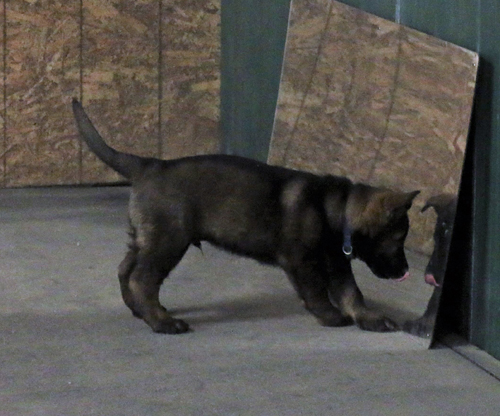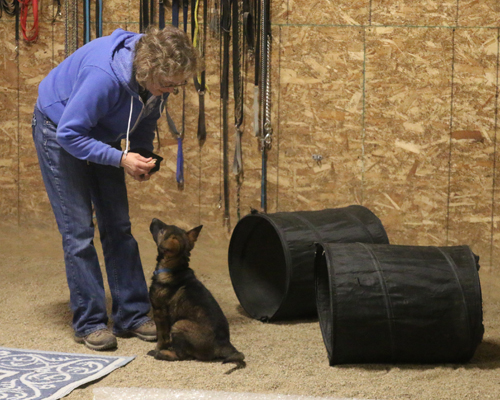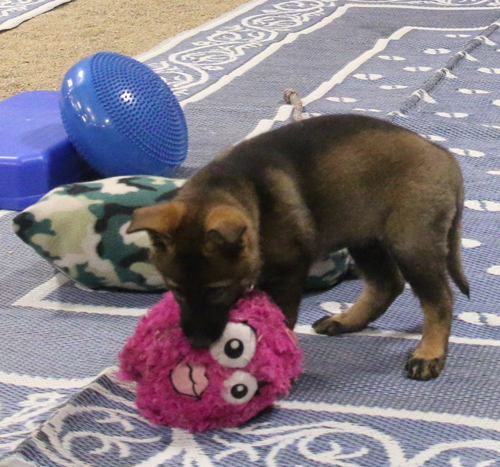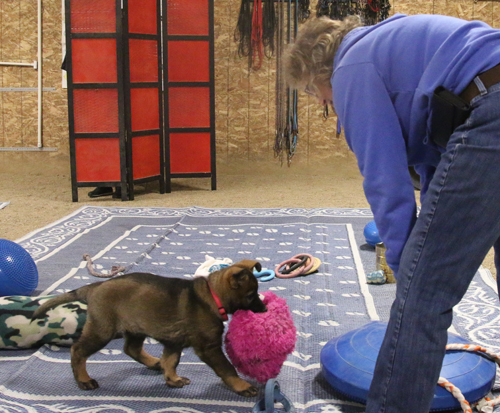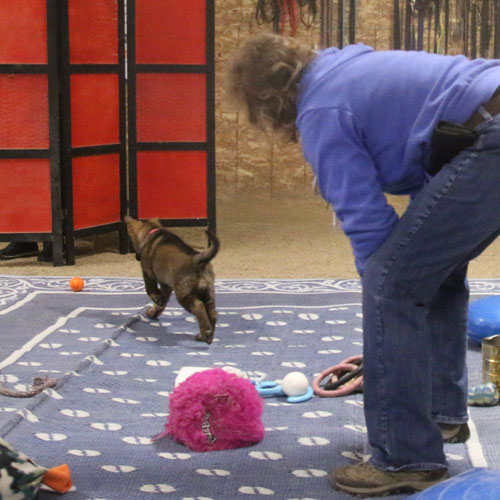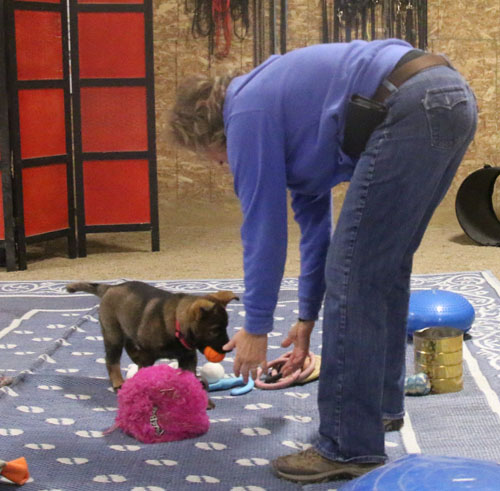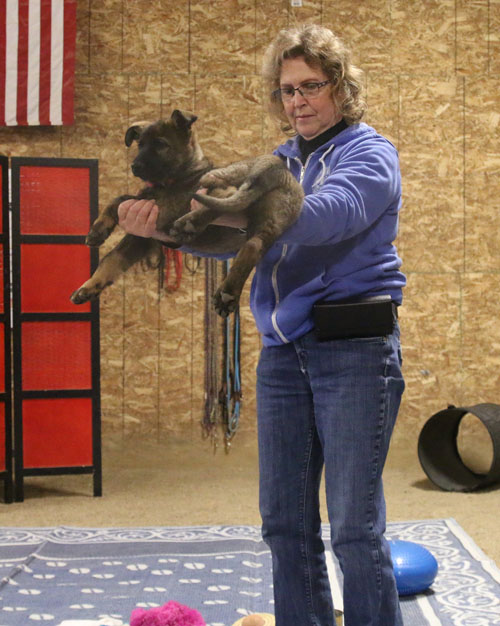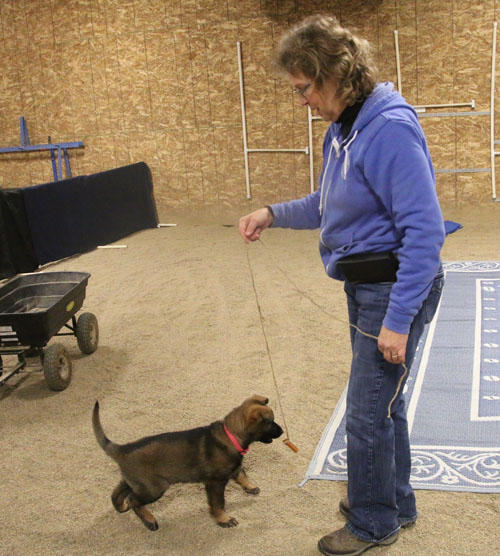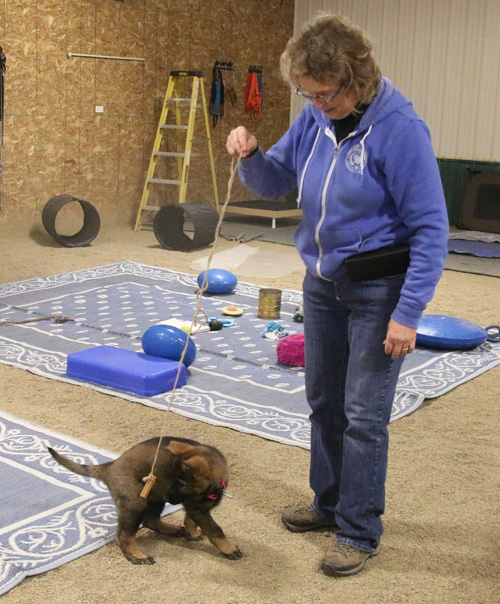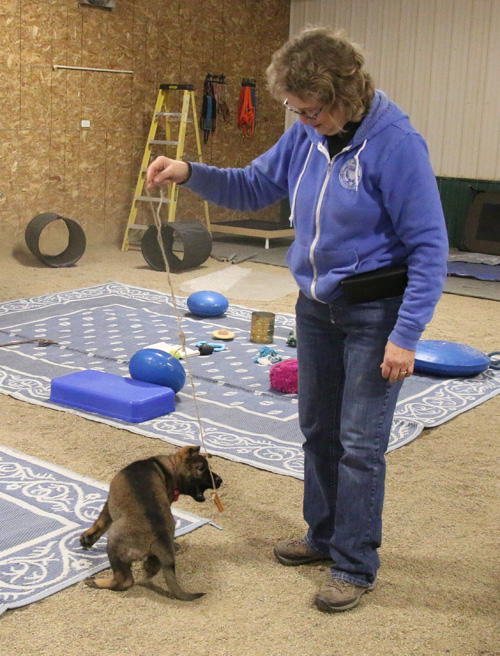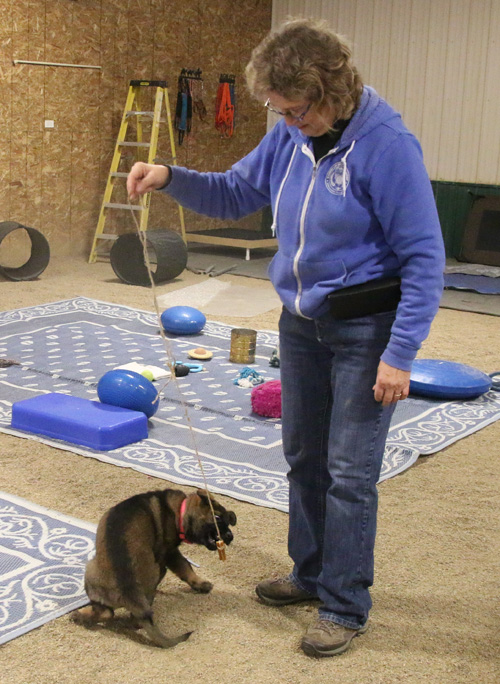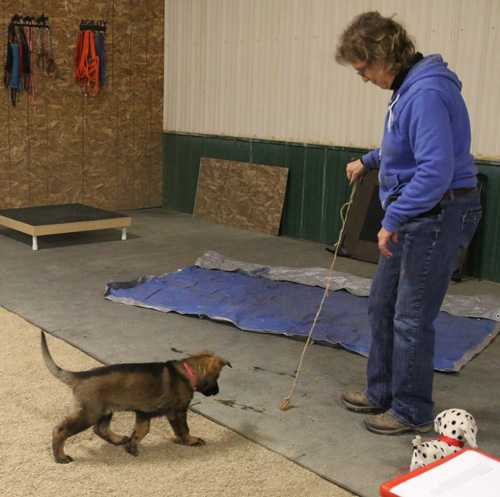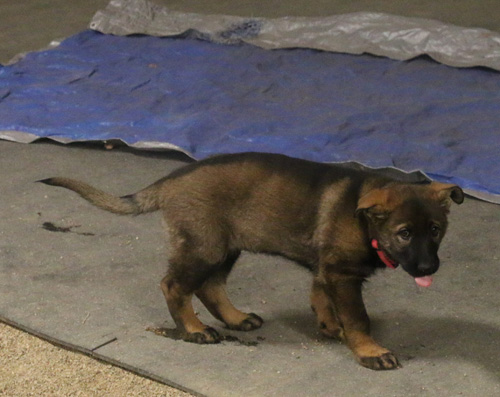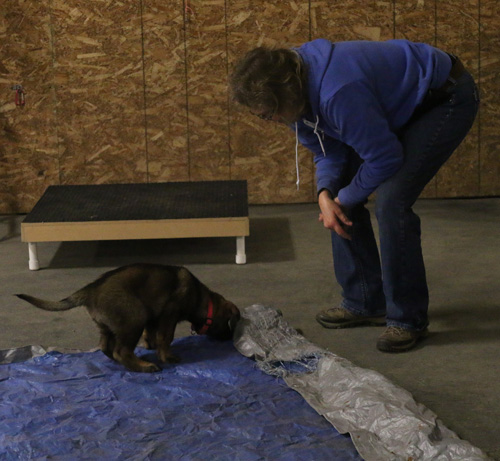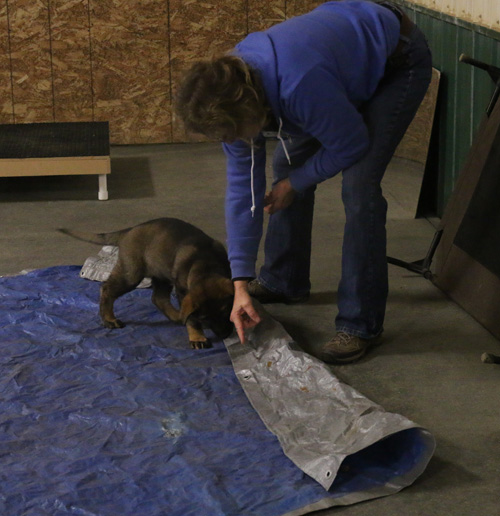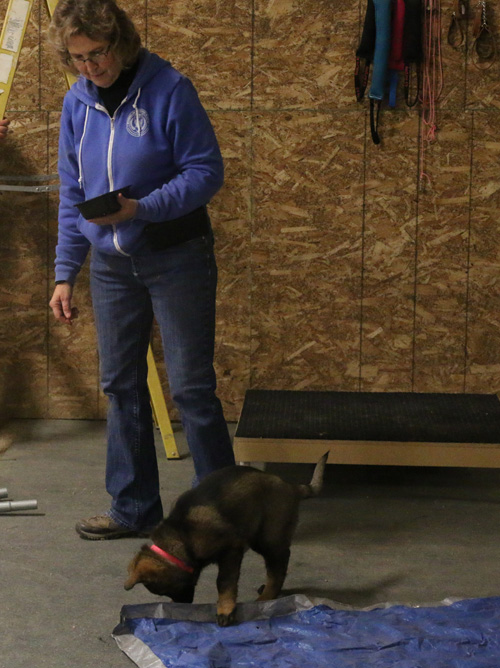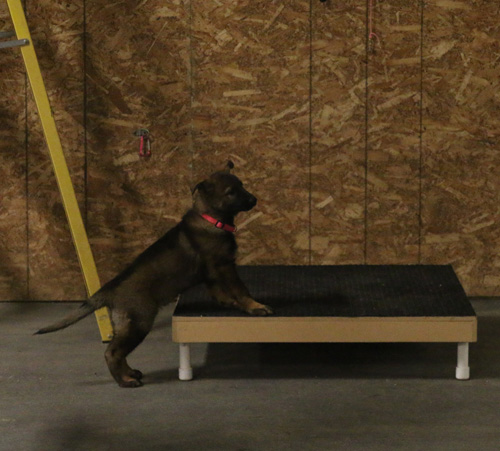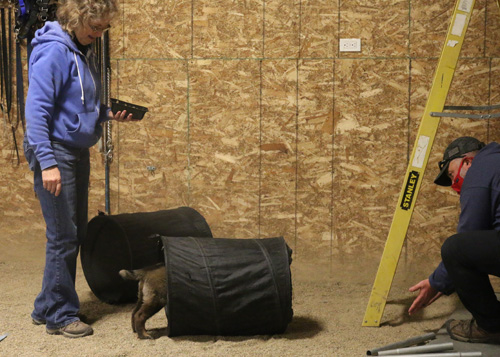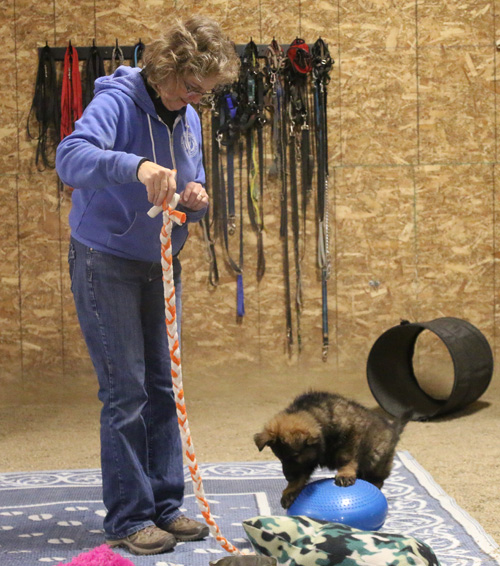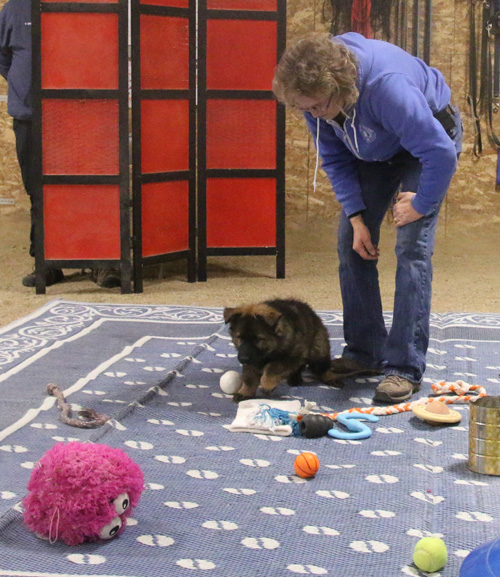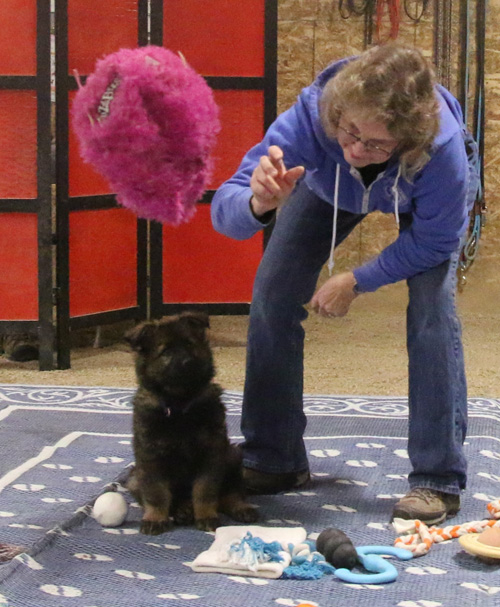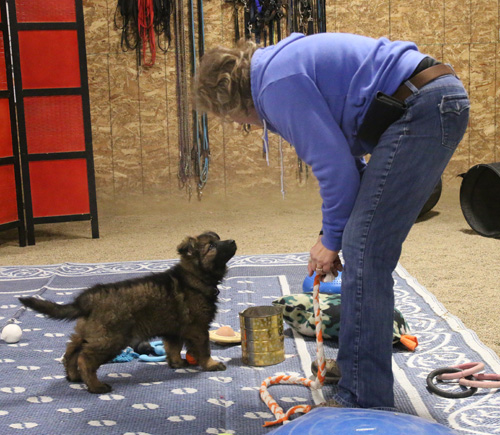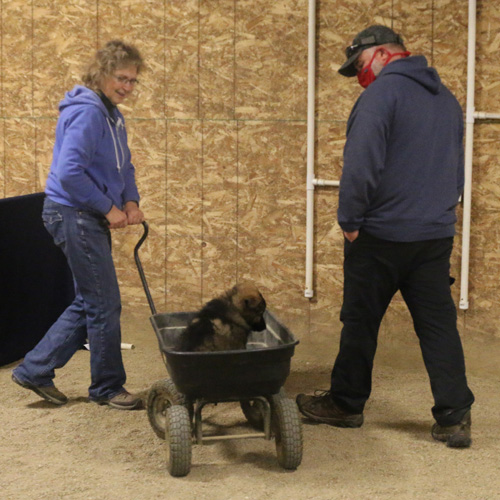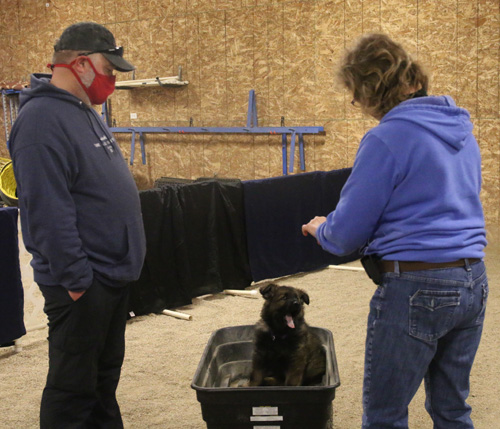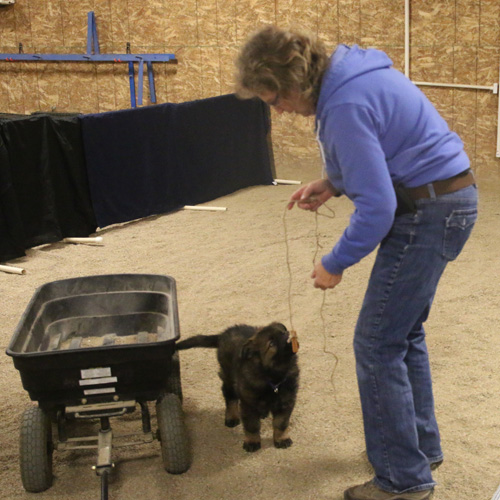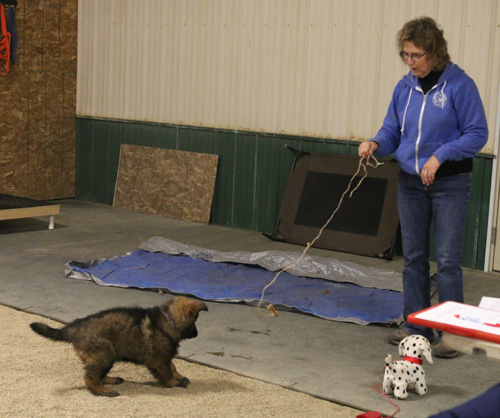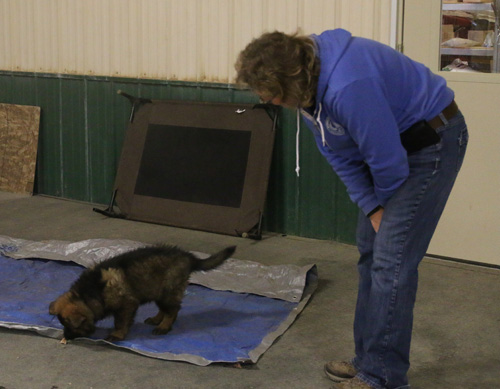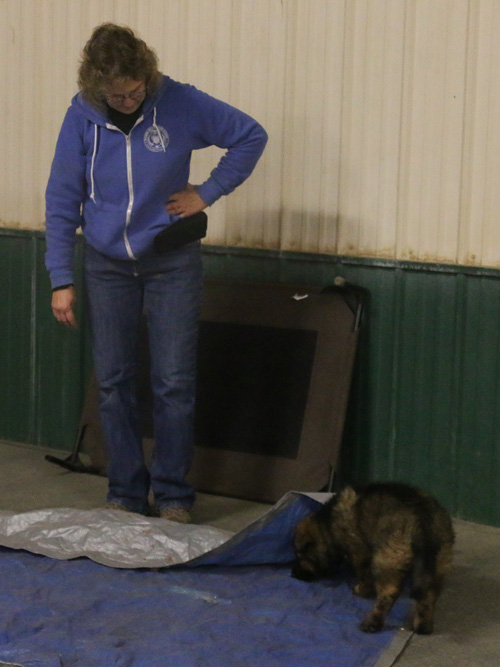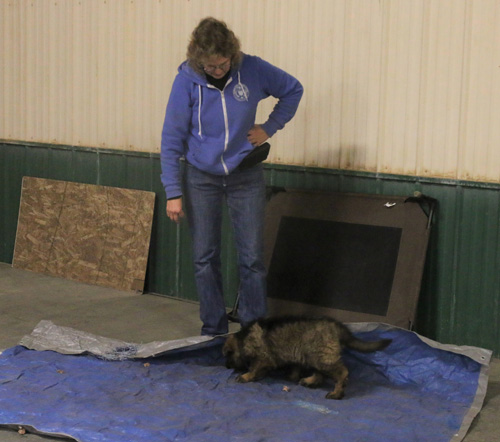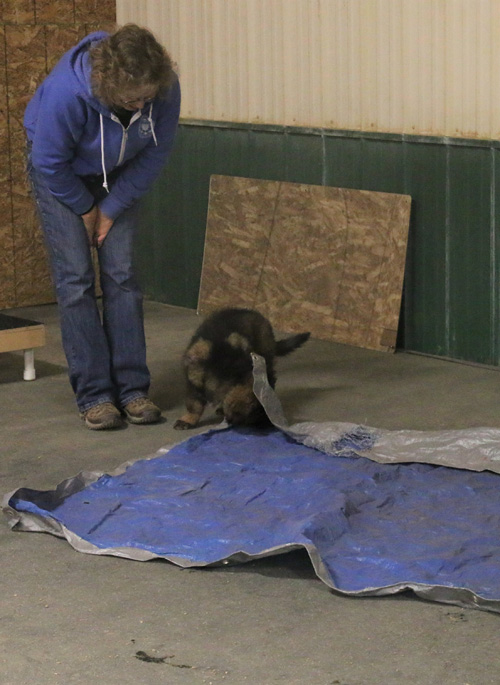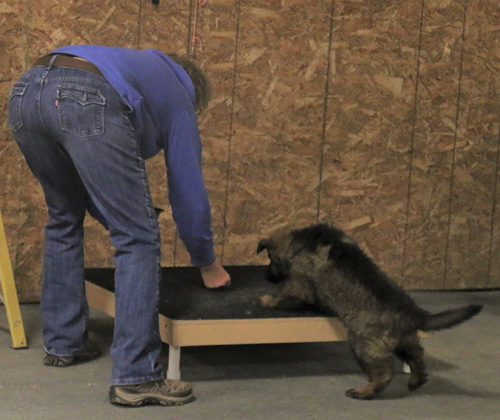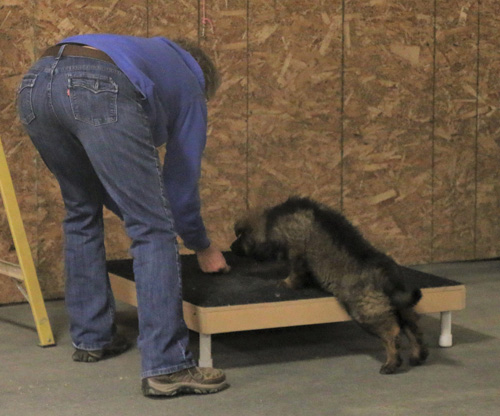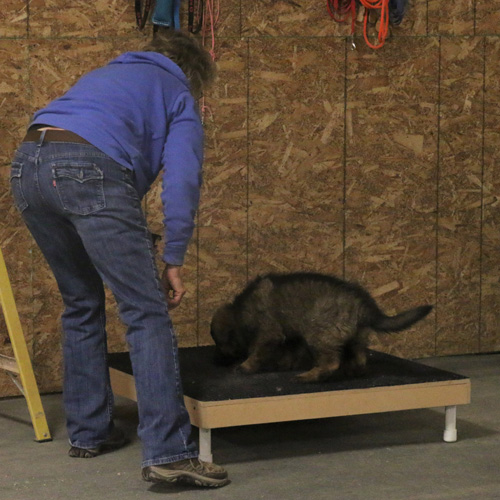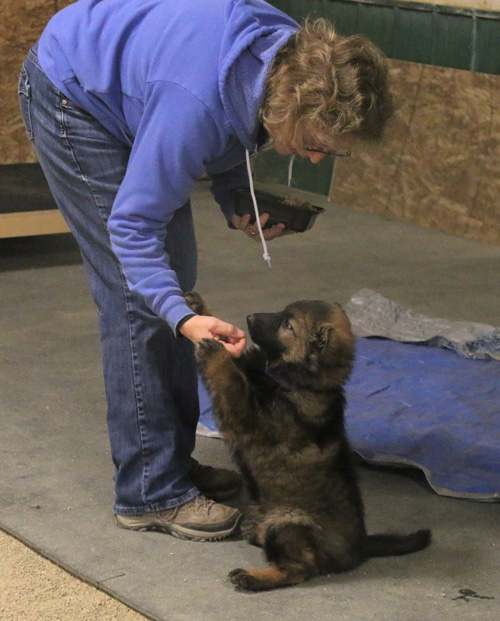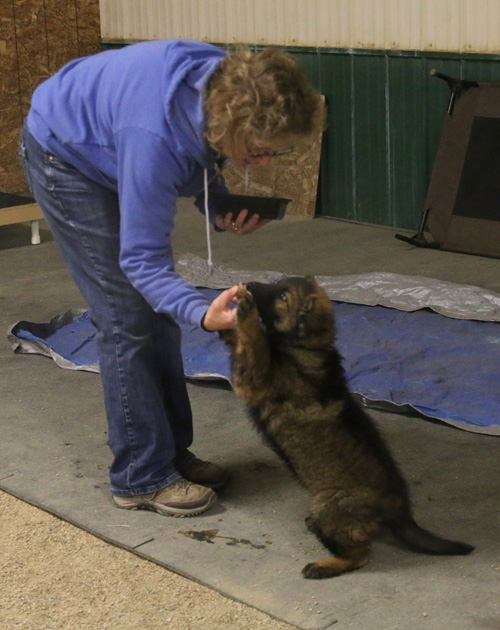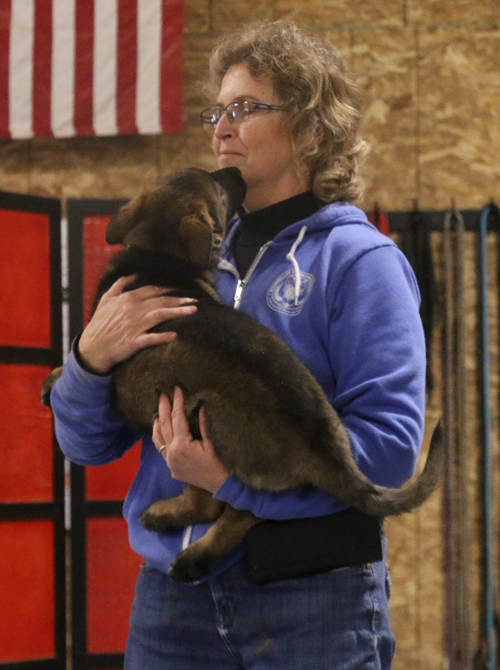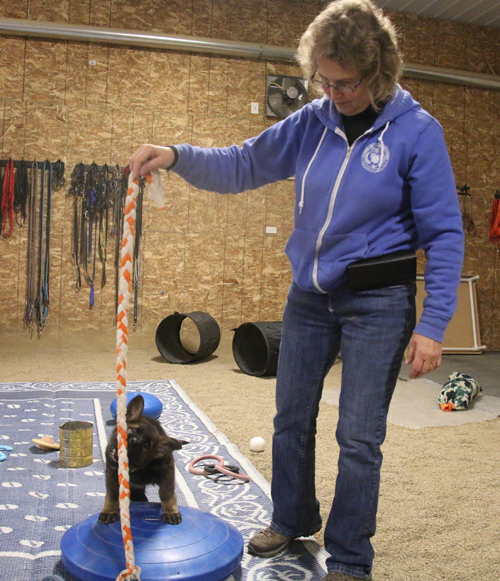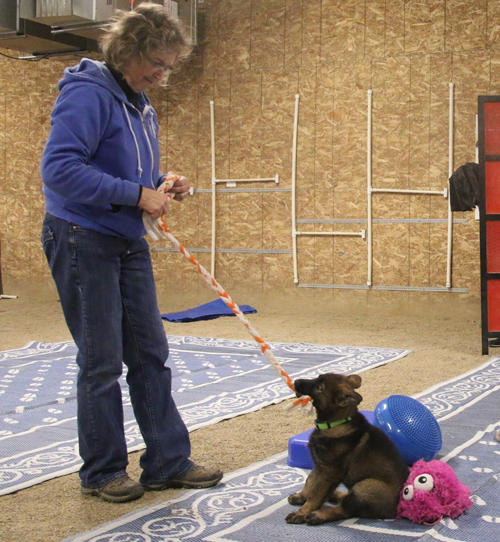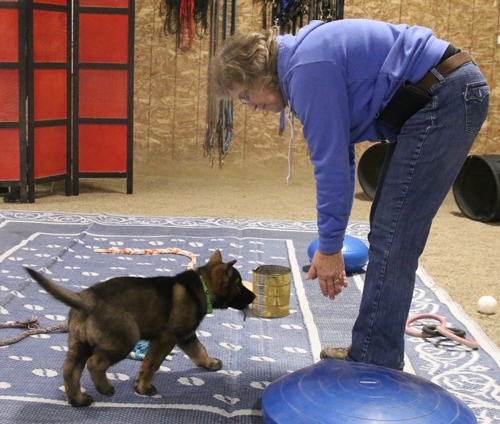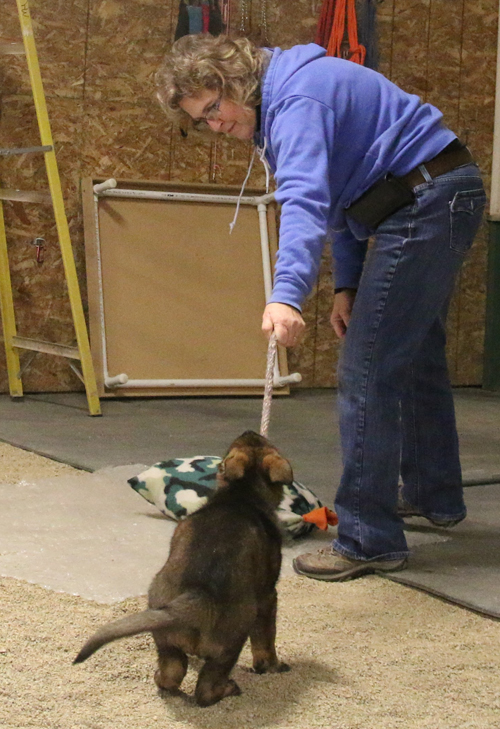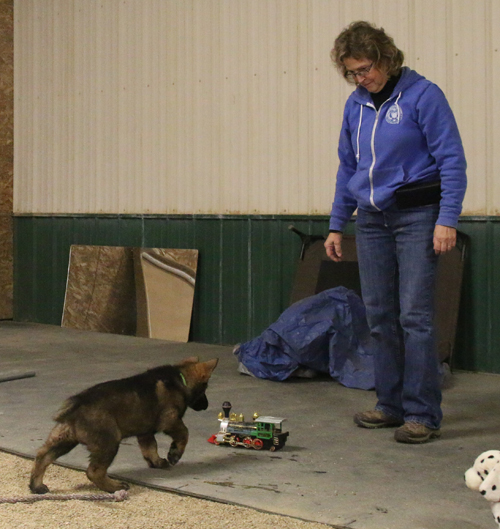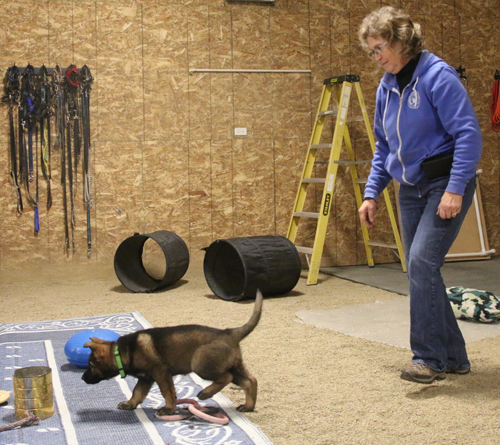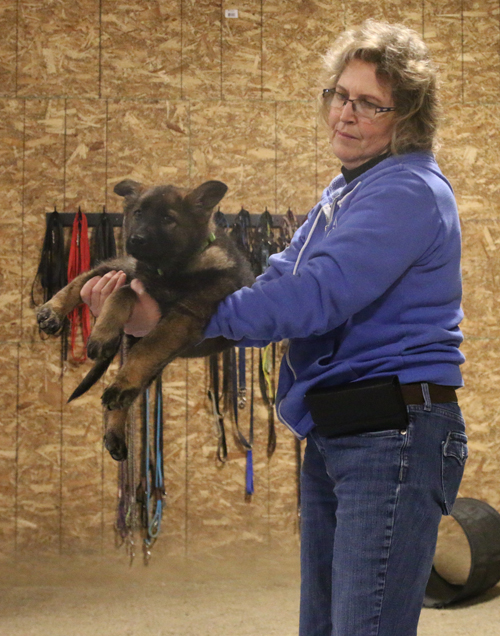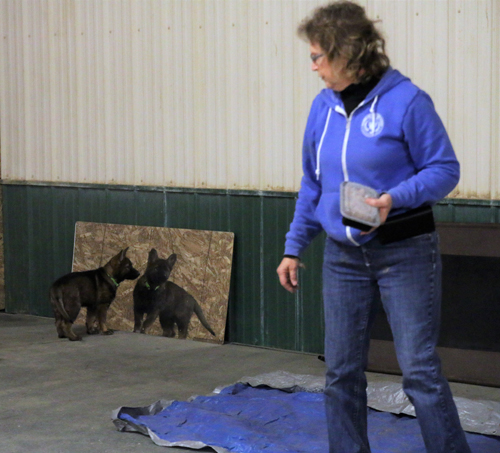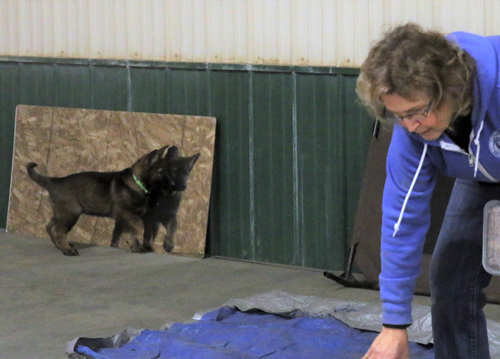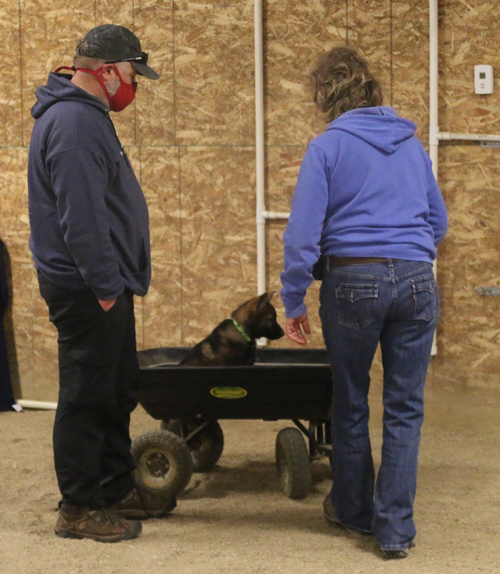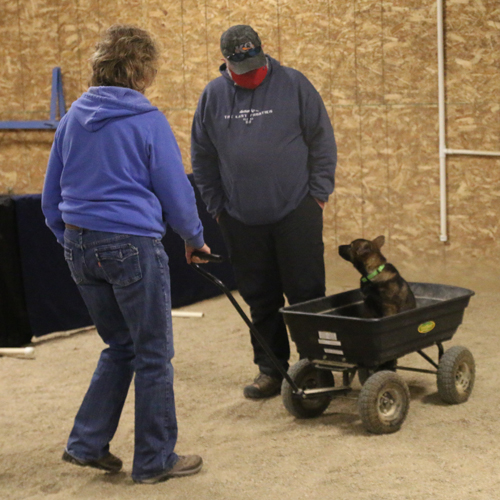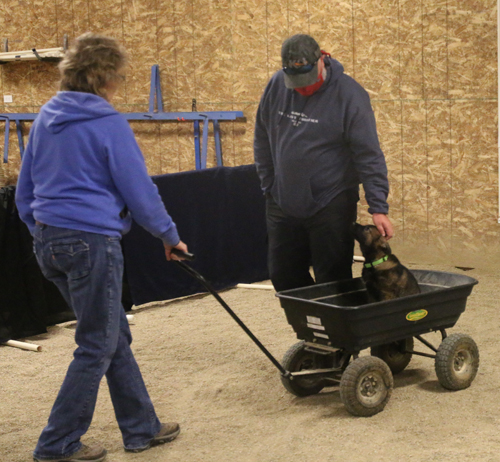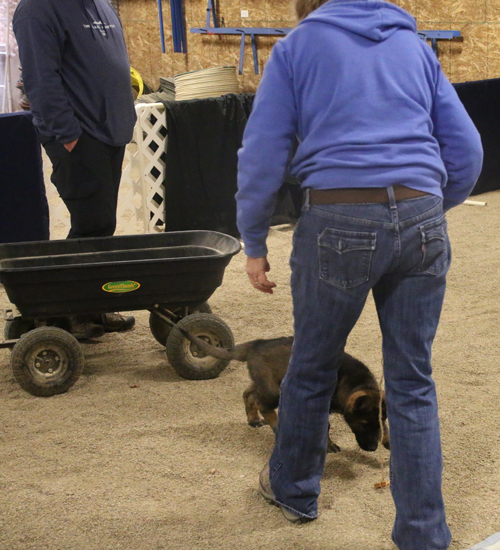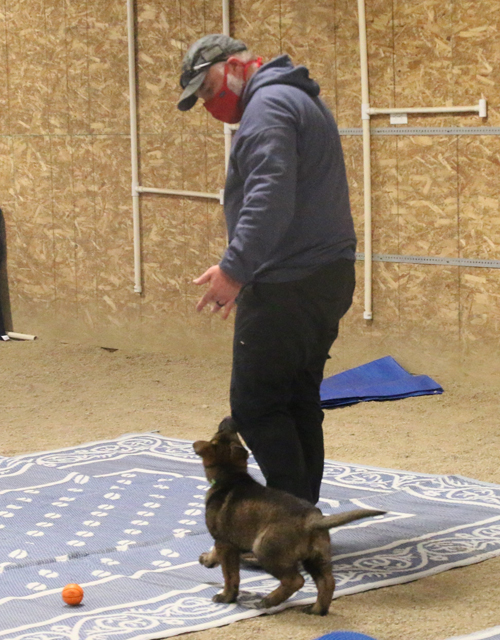VV Litter Temperament Test, page 2
Summary
Note that all pups do not have all six possible rating lines, only the ratings they received are listed.
I took photos of the test and am pleased with how they turned out. The training arena is a TERRIBLE place for photos. Either the pressed-wood walls or sand absorb light, or the metal walls and window reflect it every which way. This summer, when we did our nosework seminar, a friend from Gillette wo does a lot of photography audited one day and insisted on taking my camera and doing the photos so I could concentrate on organizational details. I am SO glad she did, because I was able to copy down the camera settings she used when we worked that afternoon in the arena. She put the camera on manual, which I had never tried because I had no one to explain how to use it. Her settings worked great today. The only problem area still is the corner where there is rubber matting, and which we used for the mirror, train and food search. I had to photoshop those to make them usable (if not great) but in previous tests I was unable to used them at all. The reactions to the mirror are priceless and I’m glad everyone can enjoy those photos.
The photos are displayed in the order in which the pups tested, which was determined by who volunteered when I opened the crate doors. Two were in one crate and two were in another. I tried to show each test at least once, depending on how the photos turned out. Often the tester blocks my view as she moves around.
Included in the photos are ones of the pups Manding and trying to communicate with Suzan. In case you haven’t been following the diary, “Manding” is an exercise I teach my pups to help break the annoying and totally natural solicitation of attention by jumping up on people (that’s what pups do to elicit attention, feeding from the mother and they transfer it to people). Instead, they learn to sit and give eye contact until you acknowledge them. It is the beginning of fantastic communication between pup and humans (and easy training!) and they are already offering it when they don’t quite understand what I want or just want praise for being so good and smart.
Mr. Blue
Excellent: Following, Social Dominance, Retrieve (keys), Pain Sensitivity, Retrieve (4 times)
Above Average: Social Attachment, Retrieve (ball, 1 time), Sound Sensitivity-train, Unstable Footing (two x’s on this)
Average-Good: Prey/perseverance, Sound Sensitivity-Rocks, Surprise/Stability, Hunt for Food I, Hunt for Food II
Minimal: Confidence/Elevation
Insufficient: Restraint/Submission (kept eye contact)
Comments: Restraint/Submission: kept eye contact.
Food search I: Not as methodical (as the others) – but still had a lot of interest in the food. Looked where directed after being coaxed several times.
Nice & solid. Retrieved keys 5 times. Curious about all. No big drives noted. Liked when he was talked to. Very enthusiastic. Nice trainable pup.
Mr. Blue’s photos show these tests (in order): Prey/Perseverance, Submission, Pain Sensitivity, Sound Sensitivity (can), Retrieve (ball & key), Sound sensitivity (train), more Prey/Perseverance, Surprise/Stability (umbrella), Wagon, Hunt for Food II, Reaction to Strange Object (mirror), him offering Manding
Miss Pink
Excellent: Retrieve, Sound sensitivity-train, Hunt for Food II, Unstable Footing
Above Average: Social Attachment, Following, Restraint/submission (two x’s on this), Confidence/Elevation, Pain Sensitivity, Sound sensitivity-rocks, Surprise/Stability, Hunt for Food I, Unstable Footing
Average: Prey/Perseverance
Minimal: Social Dominance
Comments: Hunt for Food I: Very good & systematic
Nice nose work – more air scenting
Miss Pink’s photos show these tests (in order): Unstable Footing, Retrieve, Confidence/Elevation, Sound sensitivity (train), Hunt for Food I, Hunt for Food II, her offering Manding, more Hunt for Food I, Reaction to Strange Object (battery operated stuffed dog), target table, Unstable Footing (tunnel)
Miss Purple
Excellent: Social Dominance, Hunt for Food II
Above Average: Restraint/Submission, Pain Sensitivity, Sound Sensitivity-rocks, Hunt for Food I
Average-Good: Social Attachment, Following, Retrieve, Prey/Perseverance, Sound Sensitivity-train, Surprise/Stability
Minimal: Confidence/Elevation
Comments: Hunt for Food I: tugged lightly
Encouraged with voice. Not a lot of drive. Very personable. Thinks before engaging. Good use of nose. And follows human’s directions pretty well. Systematic.
Miss Purple’s photos show these tests (in order): Unstable Footing, Retrieve, her offering Manding, cuddling because she’s SO cute, Wagon, Hunt for Food I, Hunt for Food II, target table, visiting with Suzan
Miss Green
Excellent: Restraint/submission, Social Dominance, Retrieve (4 times), Pain Sensitivity, Hunt for Food I, Unstable Footing
Above Average: Social Attachment, Following, Sound sensitivity-rocks, Sound sensitivity-train, Hunt for Food II, Unstable Footing (rated twice)
Average-Good: Retrieve (rated twice, this one for keys?), Prey/Perseverance, Surprise/Stability
Minimal: Confidence/Elevation
Comments: Surprise/Stability: Encouraged to investigate.
Very sweet! Loves the verbal encouragement. Great pup. Good nose on her and checks in with people.
Miss Green’s photos show these tests (in order): Social Attachment, Retrieve, Unstable Footing, Prey/Perseverance, more Retrieve, more Prey/Perseverance, Sound sensitivity (train), Sound Sensitivity (can), Confidence/Elevation, her offering Manding, Reaction to Strange Object (mirror), Wagon, Hunt for Food I, Hunt for Food II, naturally heeling with her new dad (though neither knew she would be his at the time)
For interest, I include the puppies’ father’s temperament test results below. Cantor was tested in Minnesota by his breeder. I did not test Hesed when she came at 8 weeks because she was extremely stressed by the flight. She had never left the puppy pen or been alone until she was put in a crate and taken to the airport.
Cantor’s Puppy Aptitude Test (father of this litter)
The puppy aptitude test that was used on Cantor is different from ours. It was originally created by Joachim and Wendy Volhard as a way to test behavioral tendencies and predict what a puppy will be like as an adult. During the test, various exercises are done with the puppy to determine the following:
- Social Attraction: how well the puppy connects to people and whether he’s confident or dependent on others
- Following: his willingness to follow a person
- Restraint: whether the puppy is more dominant or submissive and how well he can be handled in difficult situations such as vet exams
- Social Dominance: how the puppy reacts to being dominated socially, whether he tries to dominate or if he’s independent and walks away
- Elevation: how well he accepts dominance when he’s in a position of no control
- Retrieving: how willing the puppy is to do something for you
- Touch Sensitivity: how sensitive he is to being handled, which can help determine the type of training equipment you’ll need
- Sound Sensitivity: how sensitive he is to loud noises as well as being a rudimentary test for deafness
- Sight Sensitivity: how the puppy responds to moving objects, which can reveal any tendencies to chase cars or the mailman
- Stability: how startled the puppy may be when confronted with a strange object
- Structure: This is a measure of how well-formed and proportioned the puppy is physically. A puppy with a solid build will generally be healthier than one that has issues with bone alignment.
The test done on Cantor has been revised from the original Volhard test, eliminating the structure evaluation and substituting a test of energy level. It also has only five scoring options on some tests. At the end of the test I include the Volhard’s suggestions of how to evaluate the scores.
- Social Attraction
Purpose: Degree of attraction to people
Method: Place pup in testing area 4 feet from tester, who coaxes puppy to her/him
Possible Ratings/General Description
1: Comes readily, tail up, jumps, bites at hands
2: Comes readily, tail up, paws, licks at hands
3: Comes readily, tail up
4: Comes readily; tail down
5: Comes hesitantly, tail down
6: Does not come at all
Cantor’s Score: Nothing circled
Comments: Looked at sheet (covering boundaries so watchers invisible), came tail wagging
- Following
Purpose: Degree of willingness to follow human leadership
Method: Stand up and walk away from puppy, encouraging verbally
Possible Ratings/General Description
1: Follows readily, tail up, gets underfoot, bites at feet
2: Follows readily, tail up, gets underfoot
3: Follows readily, tail up
4: Follows readily, tail down
5: Follows hesitantly, tail down
6: No follow or went away
Cantor’s Score: 3
Comments: Whined, followed tester with tail wagging
- Restraint
Purpose: Degree of dominance or submission. Response to social/physical dominance.
Method: Gently roll the pup on his back and hold it for 30 seconds. Continue holding until it no longer struggles.
Possible Ratings/General Description
1: Struggles fiercely, flails, bites
2: Struggles fiercely, flails
3: Settles, struggles, settles with eye contact
4: Slight struggle, then settles
5: No struggle, tail tucked
6: No struggle, strains to avoid eye contact
Cantor’s Score: Nothing circled
Comments: Struggled, whined whole time, eye contact at end
- Social Dominance
Purpose: Degree of acceptance of human social dominance. How “forgiving” the pup is.
Method: Pup sits facing tester at a 45 degree angle. Tester strokes pups and puts his/her face close to pup.
Possible Ratings/General Description
1: Jumps, paws, bites, growls
2: Jumps, paws, licks
3: Cuddles up to tester, tries to lick face
4: Sits quietly, accepts petting, nudges/licks hands
5: Rolls over, no eye contact
6: Goes away and stays away
Cantor’s Score: 3
Comments: Licked, wagged tail
- Elevation Dominance
Purpose: Degree of accepting dominance while in position of no control
Method: Cradle the pup under its belly, fingers interlaced, and elevate just off the ground for 30 seconds
Possible Ratings/General Description
1: Struggles fiercely, bites
2: Struggles
3: No struggle, relaxed, tail wags
4: No struggle, relaxed
5: No struggle
6: No struggle, froze, tail/rear legs tense
Cantor’s Score: Nothing circled
Comments: Whined whole time, relaxed
- Retrieving (Obedience & Aptitude)
Purpose: Degree of willingness to work with humans. High correlation between ability to retrieve and successful guide dogs, obedience dogs and field trial dogs.
Method: Attract pup’s attention with crumpled paper ball. When he is watching, toss paper 4′ away. When pup goes after it, back up two feet and encourage him to come back.
Possible Ratings/General Description
1: Chases object, picks it up and runs away
2: Chases object, stands over it, does not return
3: Chases object, picks it up and returns to tester
4: Chases object, returns without object to tester
5: Starts to chase, loses interest
6: Does not chase
Cantor’s Score: 3
Comments: Went out right away, came back to tester
- Touch Sensitivity
Purpose: Degree of sensitivity to touch
Method: Take webbing of one front foot and press between finger and thumb lightly, gradually increasing pressure on a scale from 1 – 10. Stop as soon as the puppy shows discomfort.
Possible Ratings/General Description
1: 9 – 10 counts before response
2: 7 – 8 counts before response
3: 5 – 6 counts before response
4: 3 – 4 counts before response
5: 1 – 2 counts before response
Cantor’s Score: 3
Comments: none
- Sound sensitivity
Purpose: Degree of sensitivity to sound
Method: Place pup in center of testing area and make a sharp noise a few feet away. A large metal spoon struck sharply on a metal pan twice works well.
Possible Ratings/General Description
1: Locates sound & walks toward it
2: Locates sound, barks
3: Locates sound, shows curiosity, walks toward it
4: Locates sound
5: Cringes, backs, hides
6: Ignores sound, shows no curiosity
Cantor’s Score: 4
Comments: Turned and barked
- Chase Instinct
Purpose: Degree of response to moving object: chase instinct
Method: Tie a string around a towel and drag it in front of the puppy from left to right.
Possible Ratings/General Description
1: Looks, attacks, bites
2: Looks, barks, tail up
3: Looks curiously, attempts to investigate
4: Looks, does not go forward, tail down
5: Runs away, hides
6: Ignores, shows no curiosity
Cantor’s Score: 3
Comments: Showed interest. Went away then came back.
- Stability
Purpose: Degree of intelligent response to strange object
Method: Place pup in center of testing area. Closed umbrella is held 4′ away and pointed perpendicular to the direction the pup faces. The umbrella is opened and set down so the pup can investigate.
Possible Ratings/General Description
1: Walks forward, tail up, bites
2: Walks forward, tail up, mouths
3: Walks forward, attempts to investigate
4: Goes away, tail down, hides
5: Ignores, shows no curiosity
Cantor’s Score: Nothing circled
Comments: Backed away, walked to object, stopped at 1′, came back to tester
- Energy Level
Purpose: Degree of physical energy
Method: Observe pup on the other tests and score according to the most frequent activity observed. Check with breeder for confirmation.
Possible Ratings/General Description
High: Continually runs, pounces, wiggles, paws
Medium: Mostly trots, occasionally runs, pounces, wiggles
Low: Walks slowly, sits quietly, remains in position usually
Stressed: Stands rigidly, eyes roll, tail down, ears back
Cantor’s Score: high
Overall Comments: More submissive, vocal puppy, curious, fairly confident, impulsive
“How to score the test
After you’ve administered each test and recorded the results, add up the number of one’s, two’s, three’s, etc.
Mostly One’s: This puppy has aggressive tendencies and is very dominant. He would not be a good match for families with children or elderly owners since he may be quick to bite. He would likely be a difficult dog to train and would require an experienced handler.
Mostly Two’s: This puppy is dominant. He would fit well in an adult household with an owner that can be firm and consistent in handling. Once the owner has gained his respect, he can be a very good companion. However, he may be too dominant for a household with children, or too energetic for an elderly owner.
Mostly Three’s: This puppy fits best with the average owner, accepts human leadership readily and can be good with children and elderly owners. He would likely be a good dog for obedience training, although he may be fairly active.
Mostly Four’s: This puppy is submissive and would fit with most owners, getting along well with children and elderly owners. He would train well, but may be somewhat less outgoing and energetic than a puppy that scores mostly three’s.
Mostly Five’s: This puppy is very submissive. He would not be the best choice for a first-time owner because he scares easily and needs to be taught how to be more outgoing. He would need a very regimented lifestyle to feel comfortable and open up. He’s generally safe for children, but could bite out of fear if overly stressed. Training him would take a lot of patience.
Mostly Six’s: This puppy is very independent and would be difficult to work with. He’s not very people-friendly and would require an experienced handler. He shouldn’t be matched with households with children. If you also recorded several one’s with this puppy, he may be likely to bite if stressed. This is particularly true if he scores a one in restraint.
If you find that after administering the puppy aptitude test a puppy has a few of every number, you should retest him in a few days. He may not feel well. Upon retesting, if the puppy still doesn’t show a pattern in scoring, he’s likely to have erratic behavior and may not make a good pet.”
What the scores mean for you
If you’re a first-time owner, you should look for a puppy that scores mostly three’s and four’s. One with this personality should be easy to train and family-friendly. This is particularly true if he scores a three in both social attraction and social dominance. This doesn’t mean that a puppy with other scores isn’t fit to be a pet, just that he may be better suited for owners that have more training experience. The test doesn’t pick good puppies. It only points out general personality traits a puppy will have as he grows. The puppy aptitude test should only be used as a gauge for a puppy’s temperament. It’s up to each person to make his or her own decision as to the personality they would like their puppy to have and choose based on this knowledge.”
back to page 1 of the temperament test results
to VV litter page
to VV litter background information

